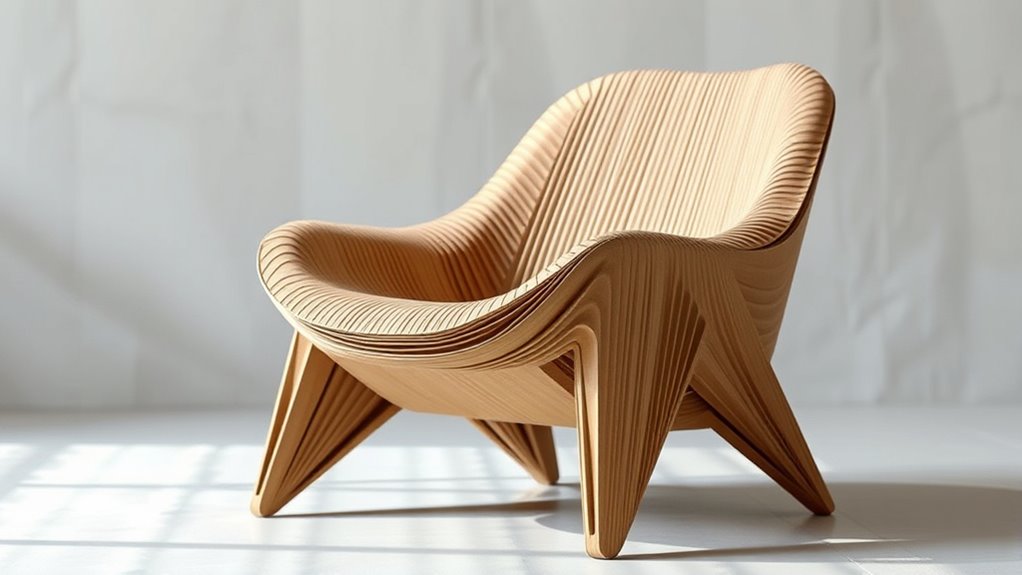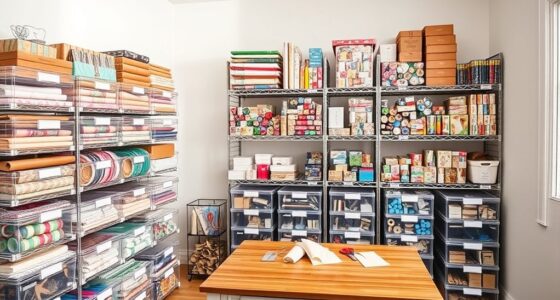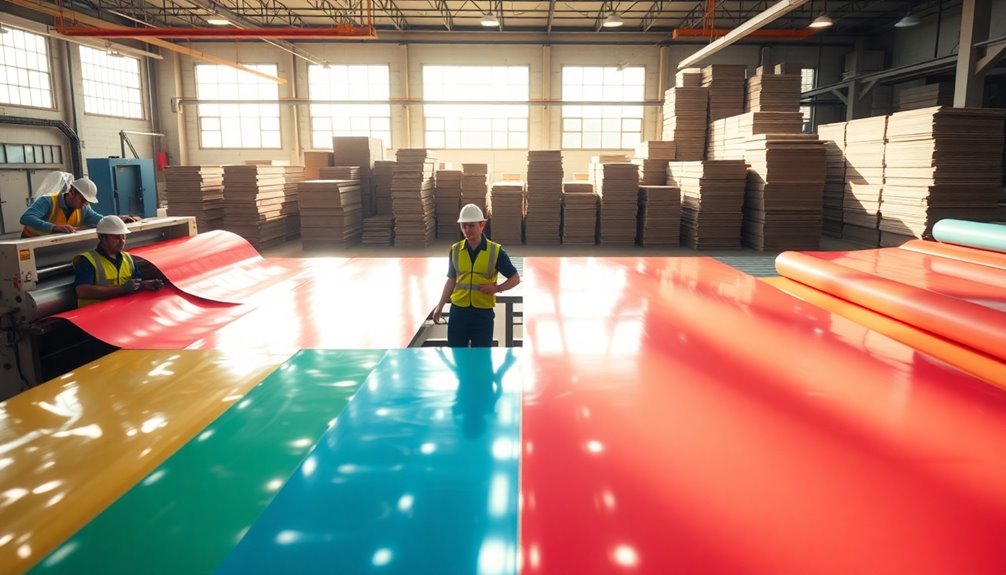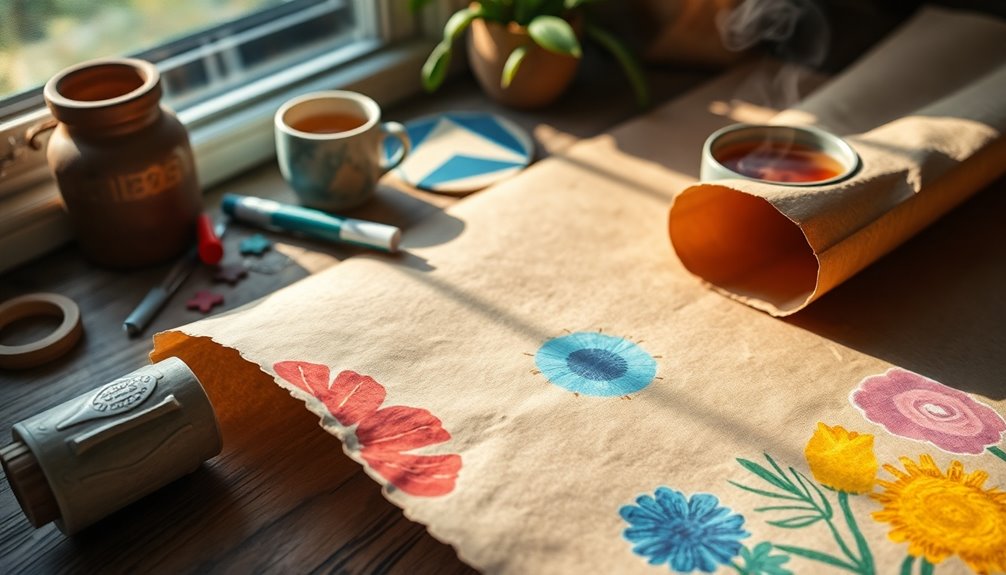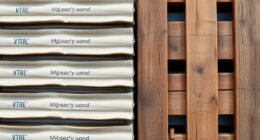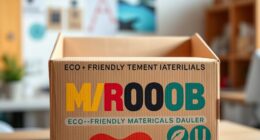Furniture made from corrugated cardboard is a fantastic eco-friendly and affordable choice that lets you upcycle waste into stylish, functional pieces. With proper design, reinforcement, and creative customization, you can build sturdy tables, shelves, or chairs that suit your space. Lightweight and easy to assemble, this type of furniture not only reduces environmental impact but also offers a satisfying DIY project. Keep exploring to discover effective tips and techniques for creating your own cardboard furniture.
Key Takeaways
- Corrugated cardboard furniture is eco-friendly, promoting recycling and reducing environmental impact.
- It is lightweight, easy to move, and suitable for creating various items like tables, shelves, and chairs.
- Proper design, layering, and reinforcement ensure durability and weight-bearing capacity.
- DIY techniques include cutting with sharp tools, using eco adhesives, and decorating for personalization.
- Modular and customizable, cardboard furniture offers versatile, cost-effective, and stylish solutions.
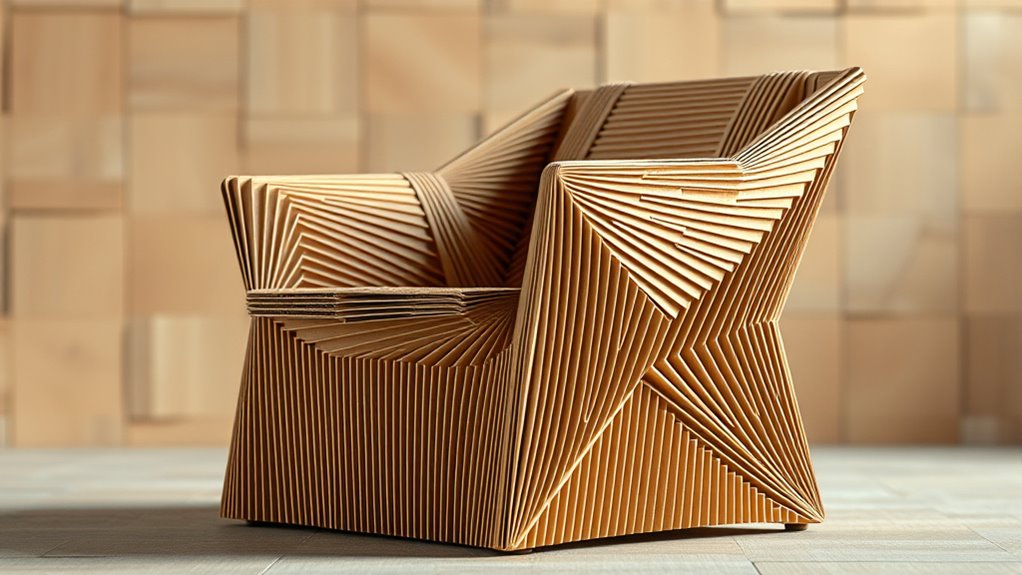
If you’re looking for an eco-friendly and affordable way to furnish your space, furniture made from corrugated cardboard offers an innovative solution. Not only does this approach promote recycling benefits by repurposing a common waste material, but it also allows you to create custom, stylish furniture pieces without breaking the bank. Corrugated cardboard is surprisingly sturdy when designed properly, making it a practical option for tables, shelves, and even chairs. Its lightweight nature means you can easily move or rearrange your furniture, giving your space flexibility and a modern, minimalist aesthetic.
One of the main advantages of using corrugated cardboard is its sustainability. Recycling benefits are significant because cardboard is highly recyclable, and by choosing this material, you reduce waste that would otherwise end up in landfills. When you opt for DIY projects using cardboard, you’re actively participating in a circular economy—upcycling waste into functional art. Plus, creating your own furniture reduces reliance on mass-produced items, lowering your carbon footprint. This eco-conscious choice not only benefits the environment but also fosters creativity and personal expression in your living or working space.
To get started with DIY design tips, focus on the structural integrity of your pieces. Use multiple layers of corrugated cardboard glued together to increase strength and stability. Reinforce stress points, especially for furniture that will bear weight, like chairs or tables. For cutting, a sharp utility knife works best, and measuring accurately ensures your pieces fit together snugly. When assembling, consider using environmentally friendly adhesives or double-sided tape to keep things safe and sustainable. You can also incorporate decorative elements, like paint or patterned paper, to give your furniture a personalized touch. A coat of primer and paint not only enhances aesthetics but also adds a layer of protection, prolonging the life of your creations.
Incorporating design tips such as modular components can make your furniture versatile and easy to modify. For example, stacking or nesting pieces can expand or reconfigure your setup as needed. You might also experiment with different textures or colors to match your decor style. Remember that proper planning is key—sketch your design beforehand and measure twice to avoid mistakes. With patience and creative thinking, your cardboard furniture can look professional and feel sturdy, challenging the misconception that eco-friendly must mean boring or fragile. By combining recycling benefits with smart DIY design tips, you turn waste into a unique statement piece that’s both sustainable and stylish, all while gaining a satisfying crafting experience. Additionally, understanding the strength of corrugated cardboard can help you optimize your designs for durability and safety.
Frequently Asked Questions
How Durable Is Corrugated Cardboard Furniture Over Time?
Corrugated cardboard furniture can be quite durable if you consider material strength and design innovations. Modern techniques reinforce the cardboard, making it sturdy enough for daily use. Proper treatment and careful construction extend its lifespan, so you can enjoy it over time. While not as long-lasting as traditional materials, innovative designs and quality materials guarantee your furniture remains functional and visually appealing, even with regular use.
Can Cardboard Furniture Hold Heavy Loads Safely?
Yes, cardboard furniture can hold heavy loads safely if you consider the weight capacity and load distribution. You need to verify the load is evenly spread across sturdy surfaces and avoid overloading any single point. Proper design and reinforcement can enhance its strength, making it suitable for supporting substantial weight. Just remember to check the weight limits and distribute the load carefully to maintain safety and durability.
Is It Suitable for Outdoor Use?
Ever wondered if cardboard furniture can withstand the outdoors? While it offers unique aesthetic appeal, it’s not naturally weather-resistant, so exposure to rain or humidity can cause damage. You might consider treating it with water-repellent coatings, but it’s still best suited for sheltered outdoor areas. If you want durable outdoor furniture, materials specifically designed for weather resistance will serve you better in the long run.
How Eco-Friendly Is the Manufacturing Process?
The manufacturing process for cardboard furniture is highly eco-friendly because it leverages recycling benefits, reducing waste and conserving resources. You’ll find that it has a smaller carbon footprint compared to traditional materials, as it uses less energy and raw materials. By choosing this eco-conscious option, you actively support sustainability efforts, helping to lower environmental impact and promote greener living practices.
What Maintenance Is Required to Prolong Its Lifespan?
Think of your cardboard furniture as a delicate vessel sailing through changing seas. To prolong its lifespan, regularly apply protective coatings to shield it from moisture and wear. When not in use, store it seasonally in a dry, sheltered spot to prevent damage from humidity or extreme temperatures. With these simple steps, you keep your eco-friendly piece sturdy and vibrant, ready to serve your needs for years to come.
Conclusion
So, next time you think about upgrading your space, consider furniture made from corrugated cardboard. It’s lightweight yet surprisingly sturdy, like a feather that can still carry a load. Not only is it eco-friendly and budget-smart, but it also sparks creativity in your home decor. With a little imagination, you can transform what seems ordinary into something extraordinary. Why not give it a try? After all, innovation is just a fold or two away from your next favorite piece.

